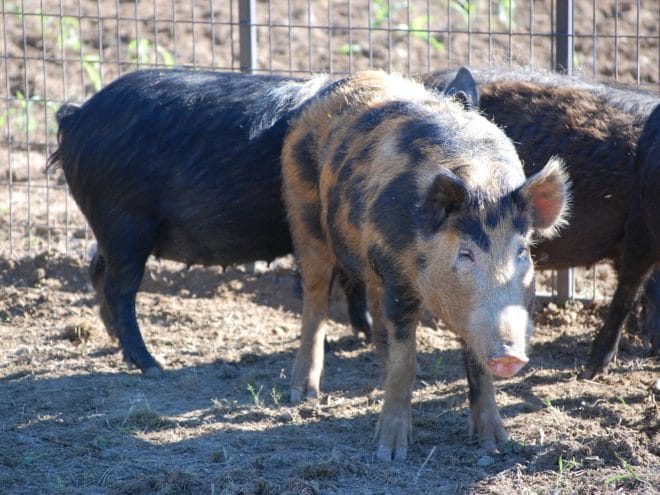Wild pigs have roamed parts of the Southeast since Spanish explorer Hernando de Soto introduced them as food for early settlers in the 16th century. But during the last two decades, Mississippi has experienced a rapid uptick in the spread of the nuisance animal.
“Before the 1990s, wild pigs were spreading by natural causes, using the typical dispersal patterns all animals have, but the No. 1 cause for the increase in wild pigs’ range has been the illegal transportation and release of wild pigs for hunting purposes, said Bronson Strickland, Mississippi State University Extension Service wildlife specialist. “This is why some areas of Mississippi that never had wild pigs suddenly have a population.”
In 1988, wild pigs existed on about 4 percent of the state’s land area. The latest estimates show that by 2009, populations had spread to 38 percent of the state’s land area.
The non-native, domestic pig species de Soto brought was managed as free-range swine until those livestock management practices were abandoned by landowners. The remaining feral population of this free-range species later bred with escaped or released Eurasian wild boars, imported in the early 1900s for hunting. Today, many hybrid species exist in at least 45 states — from the Southeast to the Pacific Northwest.
In some nearby states, including Texas and Louisiana, populations of wild pigs have reached epidemic proportions — outnumbering and outcompeting native wildlife. That is a scenario Mississippi wildlife specialists want to avoid. But managing the population is much easier said than done.
“I don’t think we have reached epidemic numbers throughout Mississippi yet, although some producers would disagree with me,” Strickland said. “However, if nothing is done and populations continue to grow and expand, we will have an epidemic. We don’t want this. If you think having a deer in your backyard eating your garden is problematic, having wild pigs in your backyard will be a nightmare.”
The nocturnal, elusive pests adapt easily to almost any environment. Their diets consist mainly of plant matter, but they will also eat worms, insects, reptiles, small mammals, and the eggs and young of ground-nesting birds. They have low natural mortality rates and can have from three to eight piglets per litter. Under ideal conditions, females can begin reproducing at 6 months old and have two litters per year.
“The second major obstacle to management is their high reproductive rate,” Strickland said. “They have very large litter sizes compared to our native wild mammals, like white-tailed deer.”
While their voracious appetites threaten to limit foods of native wildlife, wild pigs also cost humans a lot of money. A recent study by Strickland and his colleagues revealed that the nuisance animals cause between $60 million to $67 million of damage every year to crops, timber, land, equipment and structures.
“Their rooting behavior will destroy not only an agricultural crop, but also the entire field the crop is growing in,” Strickland said. “We’ve found pastures that were once used to grow hay can no longer be cut because the rooting damaged the field so badly the hay bailing equipment can no longer be used.”
The swampy, isolated landscape found in much of the Delta provides the perfect haven for the intelligent beasts, said Alex Deason, Extension agent in Sunflower County.
“In our part of the state, it stays so wet in a lot of areas that people rarely venture into those places unless it’s hunting season,” he said. “Wild pigs have these spaces solely to themselves all winter. The pigs also take advantage of absentee landowners who might not be aware of the pigs on their property.”
Spring planting beckons many herds of swine to agricultural fields rich with the freshly planted seeds and young, germinating plants wild pigs prefer. Farmers see the most damage from rooting during the early planting season. Later in the season, when crops are larger and tougher to chew, farmers see flattened areas where herds have wallowed down the plants. Timber producers have the same problem — often finding complete stands of newly planted trees destroyed overnight, Deason said.
It is a constant battle to try and mediate their damage.
“It is hard to get a plan together and can be frustrating for producers because the wild pigs have another plan to get around your plan,” Deason said. “A lot of guys have come to the realization that hunting them is fun, but it’s not helping them at all as far as reducing the population.”
Trapping is the first step in successful management of wild pig numbers. It reduces populations faster than other methods. However, trapping can be tricky for some producers because of the logistics involved, Strickland said.
“Many state and federal natural resource agencies, as well as landowners, are engaged and doing all they can do,” he said. “Unfortunately, eliminating wild pigs through trapping takes time and resources, and many people and agencies are lacking in one, the other, or both.
“This fight is fought on two fronts. First, deal with the existing wild pig populations. Second, we have to stop the illegal transportation of wild pigs. Mississippians need to report this illegal activity if they know of people turning pigs loose on the landscape,” Strickland said.
For more information about wild pigs and best management practices, visit http://www.wildpiginfo.msstate.edu.
Information provided by Mississippi State University Extension Service




